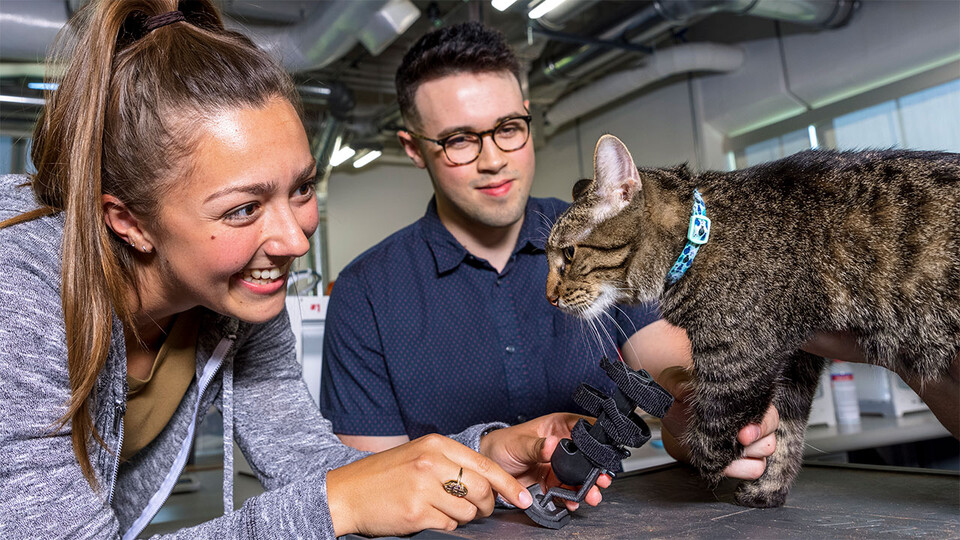Many people have an affinity for disabled animals, but caring for them can be a challenge. Such creatures can require more care and cost, especially those missing limbs. Even though low-cost 3D printers are nearly ubiquitous, not everyone is an engineer or skilled enough to design prosthetics for animals. Fortunately, the University of Nebraska-Lincoln is training a new generation of engineers. Abby Smith, Harrison Grasso, Jaden Schovanec, Rachael Stanek and Alexandra Jensen-students in Biological Systems Engineering (BSEN) 470 and BSEN 480 classes at the university-put to the test much of what they learned to create a prosthetic for a three-legged cat named Olive.

Assistant professor Beth Galles, who fostered Olive before ultimately adopting her. Image courtesy of Craig Chandler | University Communication.
They were grouped together after completing a survey of their career goals and engineering interests, one of which was prosthetics. The team was assigned a project conceived by Beth Galles, an assistant professor of practice with the Professional Program in Veterinary Medicine. Their challenge: design and create a prosthetic that was adjustable, removable, non-toxic, and cost less than $100 to produce. Over the next several months, the students refined their designs and simplified them. They decided on a two-piece prototype made mostly of polylactic acid (PLA) and a sturdy proprietary plastic.
The final prototype, which could be made for just $10, had a unique design: to replicate the functions of a paw, the device terminates in a short, curved base, featuring a rubber lining for traction. The upper area of the prosthetic is made up of three walls with an open covering. This is topped off with a cup where the cat’s nub is placed. The team found it challenging to securely attach the device to Olive’s limb, even with Velcro straps and a silicone sheathe designed specifically for such an application.

Renderings of the prosthetic limb, which was printed at Nebraska Innovation Studio and weighs less than an ounce. Image courtesy of University of Nebraska.
“That was one of the biggest problems we encountered, was keeping this thing on,” Smith told University Today. “(Olive) had very slick fur and a lot of loose skin at the end of the amputation site. The silicone sleeve that we put directly on her was key in helping the prosthetic stay on.”
As anyone who has owned a cat can attest, they dislike anything bothering their paws. Olive’s instinct was to shake the prosthetic off as soon as she was fitted with it. Ultimately, she started to put the prosthetic foot on the ground. Then, she slowly started taking steps on it. By the third test, Olive began to engage in regular house cat activity that she had been too hesitant to try before the prosthesis, jumping onto and off of ledges.
Creating a prosthetic for any animal is a challenge. There are only ten known animal orthotists in the world. In certain cases, animals have been euthanized because there was no way to restore their mobility or their ability to eat properly. However, 3D printing is changing that. A bald eagle and a graylag goose were both missing most of their beaks and were unable to eat on their own…that is, until a dentist stepped in. Now with the aid of 3D printed beaks, they are living in the wild again. There are myriad similar examples, from an alligator getting a new silicone tail made from a 3D model and a tortoise receiving a new shell printed from just a desktop printer, to birds with new limbs also printed from desktop systems you would find in a home or a school, and even miniature horses getting new legs. DiveDesign & Bionic Pets are just two firms that are revolutionizing the field of animal prosthetics.
As their senior design project, @UNLincoln students Abby Smith and Harrison Grasso used Nebraska Innovation Studio’s (@NIS_Makers) 3D printers to prototype a prosthetic leg for a cat. #Huskers #cats #3Dprinting #Makerspace #LNK #Nebraska pic.twitter.com/54JpLSUp8T
— NIC (@NIC_Innovates) May 14, 2021
As for Smith and Grasso, they said that they gained plenty from the experience. Smith used it as a smooth on-ramp for her new job with ARYSE, a Lincoln-based startup 3D printing form-fitting braces designed to protect athletes. Grasso is currently applying to medical school, hoping to use this experience to design innovative medical devices. As for Olive, she not only received a new leg, but also a home and family after Galles adopted her.
Subscribe to Our Email Newsletter
Stay up-to-date on all the latest news from the 3D printing industry and receive information and offers from third party vendors.
You May Also Like
3D Printing Webinar and Event Roundup: April 21, 2024
It’s another busy week of webinars and events, starting with Hannover Messe in Germany and continuing with Metalcasting Congress, Chinaplas, TechBlick’s Innovation Festival, and more. Stratasys continues its advanced training...
3D Printing Webinar and Event Roundup: March 30, 2024
Things are slowing down a little this week, but there are still several interesting 3D printing webinars and events for you to attend. Read on for all the details! 3D...
3DPOD Episode 191: Amy Alexander, 3D Printing at the Mayo Clinic
Amy Alexander leads the 3D printing initiatives at the Mayo Clinic. You’ll be astounded by the ambitious plans this hospital has for additive manufacturing. In this episode of the 3DPOD,...
3D Printing Webinar and Event Roundup: March 3, 2024
In this week’s roundup, we have a lot of events taking place, including SPE’s ANTEC 2024, Futurebuild, the AAOP Annual Meeting, JEC World, and more. Stratasys continues its training courses,...
































